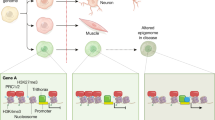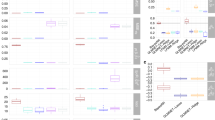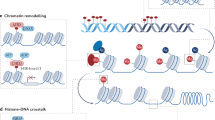Abstract
The epigenome has been heralded as a key 'missing piece' of the aetiological puzzle for complex phenotypes across the biomedical sciences. The standard research approaches developed for genetic epidemiology, however, are not necessarily appropriate for epigenetic studies of common disease. Here, we discuss the optimal execution of population-based studies of epigenetic variation, which will contribute to the emerging field of 'epigenetic epidemiology' and emphasize the importance of establishing a causal role in pathology for disease-associated epigenetic changes. We propose that improved understanding of the molecular mechanisms underlying human health and disease are best achieved through carrying out studies of epigenetics in populations as a part of an integrated functional genomics strategy.
This is a preview of subscription content, access via your institution
Access options
Subscribe to this journal
Receive 12 print issues and online access
$189.00 per year
only $15.75 per issue
Buy this article
- Purchase on Springer Link
- Instant access to full article PDF
Prices may be subject to local taxes which are calculated during checkout


Similar content being viewed by others
References
Visscher, P. M., Brown, M. A., McCarthy, M. I. & Yang, J. Five years of GWAS discovery. Am. J. Hum. Genet. 90, 7–24 (2012).
Bernstein, B. E. et al. An integrated encyclopedia of DNA elements in the human genome. Nature 489, 57–74 (2012).
Relton, C. L. & Davey Smith, G. Is epidemiology ready for epigenetics? Int. J. Epidemiol. 41, 5–9 (2012).
Rakyan, V. K., Down, T. A., Balding, D. J. & Beck, S. Epigenome-wide association studies for common human diseases. Nature Rev. Genet. 12, 529–541 (2011).
Heyn, H. & Esteller, M. DNA methylation profiling in the clinic: applications and challenges. Nature Rev. Genet. 13, 679–692 (2012).
Tomizawa, S. & Sasaki, H. Genomic imprinting and its relevance to congenital disease, infertility, molar pregnancy and induced pluripotent stem cell. J. Hum. Genet. 57, 84–91 (2012).
Baylin, S. B. & Jones, P. A. A decade of exploring the cancer epigenome — biological and translational implications. Nature Rev. Cancer 11, 726–734 (2011).
Feil, R. & Fraga, M. F. Epigenetics and the environment: emerging patterns and implications. Nature Rev. Genet. 12, 97–109 (2011).
Joubert, B. R. et al. 450K epigenome-wide scan identifies differential DNA methylation in newborns related to maternal smoking during pregnancy. Environ. Health Perspect. 120, 1425–1431 (2012).
Breitling, L. P., Yang, R., Korn, B., Burwinkel, B. & Brenner, H. Tobacco-smoking-related differential DNA methylation: 27K discovery and replication. Am. J. Hum. Genet. 88, 450–457 (2011).
Monick, M. M. et al. Coordinated changes in AHRR methylation in lymphoblasts and pulmonary macrophages from smokers. Am. J. Med. Genet. B 159, 141–151 (2012).
Landan, G. et al. Epigenetic polymorphism and the stochastic formation of differentially methylated regions in normal and cancerous tissues. Nature Genet. 44, 1207–1214 (2012).
Feinberg, A. P. & Irizarry, R. A. Evolution in health and medicine Sackler colloquium: stochastic epigenetic variation as a driving force of development, evolutionary adaptation, and disease. Proc. Natl Acad. Sci. USA 107 (Suppl. 1), 1757–1764 (2010).
Jeffries, A. R. et al. Stochastic choice of allelic expression in human neural stem cells. Stem Cells 30, 1938–1947 (2012).
Smith, G. D. Epidemiology, epigenetics and the 'gloomy prospect': embracing randomness in population health research and practice. Int. J. Epidemiol. 40, 537–562 (2011).
Godfrey, K. M., Gluckman, P. D. & Hanson, M. A. Developmental origins of metabolic disease: life course and intergenerational perspectives. Trends Endocrinol. Metab. 21, 199–205 (2010).
Bateson, P. et al. Developmental plasticity and human health. Nature 430, 419–421 (2004).
Tobi, E. W. et al. DNA methylation differences after exposure to prenatal famine are common and timing- and sex-specific. Hum. Mol. Genet. 18, 4046–4053 (2009).
Kuehnen, P. et al. An Alu element-associated hypermethylation variant of the POMC gene is associated with childhood obesity. PLoS Genet. 8, e1002543 (2012).
van Dongen, J., Slagboom, P. E., Draisma, H. H., Martin, N. G. & Boomsma, D. I. The continuing value of twin studies in the omics era. Nature Rev. Genet. 13, 640–653 (2012).
Kaminsky, Z., Wang, S. C. & Petronis, A. Complex disease, gender and epigenetics. Ann. Med. 38, 530–544 (2006).
Kong, A. et al. Parental origin of sequence variants associated with complex diseases. Nature 462, 868–874 (2009).
Heijmans, B. T. & Mill, J. Commentary: the seven plagues of epigenetic epidemiology. Int. J. Epidemiol. 41, 74–78 (2012).
The Wellcome Trust Case Control Consortium. Genome-wide association study of 14,000 cases of seven common diseases and 3,000 shared controls. Nature 447, 661–678 (2007).
Bell, J. T. et al. Epigenome-wide scans identify differentially methylated regions for age and age-related phenotypes in a healthy ageing population. PLoS Genet. 8, e1002629 (2012).
Houseman, E. A. et al. DNA methylation arrays as surrogate measures of cell mixture distribution. BMC Bioinformatics 13, 86 (2012).
Leek, J. T. et al. Tackling the widespread and critical impact of batch effects in high-throughput data. Nature Rev. Genet. 11, 733–739 (2010).
Relton, C. L. & Davey Smith, G. Two-step epigenetic Mendelian randomization: a strategy for establishing the causal role of epigenetic processes in pathways to disease. Int. J. Epidemiol. 41, 161–176 (2012).
Boks, M. P. et al. Current status and future prospects for epigenetic psychopharmacology. Epigenetics 7, 20–28 (2012).
Laird, P. W. Principles and challenges of genomewide DNA methylation analysis. Nature Rev. Genet. 11, 191–203 (2010).
Sandoval, J. et al. Validation of a DNA methylation microarray for 450,000 CpG sites in the human genome. Epigenetics 6, 692–702 (2011).
Ng, J. W. et al. The role of longitudinal cohort studies in epigenetic epidemiology: challenges and opportunities. Genome Biol. 13, 246 (2012).
Barres, R. et al. Acute exercise remodels promoter methylation in human skeletal muscle. Cell. Metab. 15, 405–411 (2012).
Gordon, L. et al. Neonatal DNA methylation profile in human twins is specified by a complex interplay between intrauterine environmental and genetic factors, subject to tissue-specific influence. Genome Res. 22, 1395–1406 (2012).
Khulan, B. et al. Periconceptional maternal micronutrient supplementation is associated with widespread gender related changes in the epigenome: a study of a unique resource in the Gambia. Hum. Mol. Genet. 21, 2086–2101 (2012).
Bock, C. Analysing and interpreting DNA methylation data. Nature Rev. Genet. 13, 705–719 (2012).
Riggs, A. D., Xiong, Z., Wang, L. & LeBon, J. M. in Novartis Foundation Symposium 214 — Epigenetics (eds Chadwick, D. K. & Cardew, G.) 214–232 (1998).
Davies, M. N. et al. Functional annotation of the human brain methylome identifies tissue-specific epigenetic variation across brain and blood. Genome Biol. 13, R43 (2012).
Vanhees, K. et al. Epigenetics: prenatal exposure to genistein leaves a permanent signature on the hematopoietic lineage. FASEB J. 25, 797–807 (2011).
Talens, R. P. et al. Epigenetic variation during the adult lifespan: cross-sectional and longitudinal data on monozygotic twin pairs. Aging Cell 11, 694–703 (2012).
Jaffe, A. E. et al. Bump hunting to identify differentially methylated regions in epigenetic epidemiology studies. Int. J. Epidemiol. 41, 200–209 (2012).
Lee, H. et al. DNA methylation shows genome-wide association of NFIX, RAPGEF2 and MSRB3 with gestational age at birth. Int. J. Epidemiol. 41, 188–199 (2012).
Wang, H. et al. Widespread plasticity in CTCF occupancy linked to DNA methylation. Genome Res. 22, 1680–1688 (2012).
Stoger, R. The thrifty epigenotype: an acquired and heritable predisposition for obesity and diabetes? Bioessays 30, 156–166 (2008).
Horvath, S. et al. Aging effects on DNA methylation modules in human brain and blood tissue. Genome Biol. 13, R97 (2012).
Hellman, A. & Chess, A. Gene body-specific methylation on the active X chromosome. Science 315, 1141–1143 (2007).
Maunakea, A. K. et al. Conserved role of intragenic DNA methylation in regulating alternative promoters. Nature 466, 253–257 (2010).
Gelfman, S., Cohen, N., Yearim, A. & Ast, G. DNA-methylation effect on cotranscriptional splicing is dependent on GC architecture of the exon-intron structure. Genome Res. 23, 789–799 (2013).
Aran, D., Sabato, S. & Hellman, A. DNA methylation of distal regulatory sites characterizes dysregulation of cancer genes. Genome Biol. 14, R21 (2013).
Klug, M. & Rehli, M. Functional analysis of promoter CpG methylation using a CpG-free luciferase reporter vector. Epigenetics 1, 127–130 (2006).
Bocker, M. T. et al. Genome-wide promoter DNA methylation dynamics of human hematopoietic progenitor cells during differentiation and aging. Blood 117, e182–189 (2011).
Gong, L., Pan, Y. X. & Chen, H. Gestational low protein diet in the rat mediates Igf2 gene expression in male offspring via altered hepatic DNA methylation. Epigenetics 5, 619–626 (2010).
Bernstein, B. E. et al. The NIH Roadmap Epigenomics Mapping Consortium. Nature Biotech. 28, 1045–1048 (2010).
[No authors listed.] Time for the epigenome. Nature 463, 587 (2010).
Dempster, E. L. et al. Disease-associated epigenetic changes in monozygotic twins discordant for schizophrenia and bipolar disorder. Hum. Mol. Genet. 20, 4786–4796 (2011).
Guintivano, J., Aryee, M. J. & Kaminsky, Z. A. A cell epigenotype specific model for the correction of brain cellular heterogeneity bias and its application to age, brain region and major depression. Epigenetics 8, 290–302 (2013).
Liu, Y. et al. Epigenome-wide association data implicate DNA methylation as an intermediary of genetic risk in rheumatoid arthritis. Nature Biotech. 31, 142–147 (2013).
Grossniklaus, U., Kelly, B., Ferguson-Smith, A. C., Pembrey, M. & Lindquist, S. Transgenerational epigenetic inheritance: how important is it? Nature Rev. Genet. 14, 228–235 (2013).
Daxinger, L. & Whitelaw, E. Transgenerational epigenetic inheritance: more questions than answers. Genome Res. 20, 1623–1628 (2010).
Daxinger, L. & Whitelaw, E. Understanding transgenerational epigenetic inheritance via the gametes in mammals. Nature Rev. Genet. 13, 153–162 (2012).
Pembrey, M. E. Male-line transgenerational responses in humans. Hum. Fertil. 13, 268–271 (2010).
Kaati, G., Bygren, L. O., Pembrey, M. & Sjostrom, M. Transgenerational response to nutrition, early life circumstances and longevity. Eur. J. Hum. Genet. 15, 784–790 (2007).
Sasaki, H. & Matsui, Y. Epigenetic events in mammalian germ-cell development: reprogramming and beyond. Nature Rev. Genet. 9, 129–140 (2008).
Weaver, I. C. et al. Epigenetic programming by maternal behavior. Nature Neurosci. 7, 847–854 (2004).
Crews, D. et al. Epigenetic transgenerational inheritance of altered stress responses. Proc. Natl Acad. Sci. USA 109, 9143–9148 (2012).
Seisenberger, S. et al. The dynamics of genome-wide DNA methylation reprogramming in mouse primordial germ cells. Mol. Cell 48, 849–862 (2012).
Borgel, J. et al. Targets and dynamics of promoter DNA methylation during early mouse development. Nature Genet. 42, 1093–1100 (2010).
Slatkin, M. Epigenetic inheritance and the missing heritability problem. Genetics 182, 845–850 (2009).
Schalkwyk, L. C. et al. Allelic skewing of DNA methylation is widespread across the genome. Am. J. Hum. Genet. 86, 196–212 (2010).
Gamazon, E. R. et al. Enrichment of cis-regulatory gene expression SNPs and methylation quantitative trait loci among bipolar disorder susceptibility variants. Mol Psych. 18, 340–346 (2012).
Meaburn, E. L., Schalkwyk, L. C. & Mill, J. Allele-specific methylation in the human genome: implications for genetic studies of complex disease. Epigenetics 5, 578–582 (2010).
Jablonka, E. Epigenetic epidemiology. Int. J. Epidemiol. 33, 929–935 (2004).
Waterland, R. A. & Michels, K. B. Epigenetic epidemiology of the developmental origins hypothesis. Annu. Rev. Nutr. 27, 363–388 (2007).
Zhou, V. W., Goren, A. & Bernstein, B. E. Charting histone modifications and the functional organization of mammalian genomes. Nature Rev. Genet. 12, 7–18 (2011).
Raiber, E. A. et al. Genome-wide distribution of 5-formylcytosine in embryonic stem cells is associated with transcription and depends on thymine DNA glycosylase. Genome Biol. 13, R69 (2012).
Yu, M. et al. Base-resolution analysis of 5-hydroxymethylcytosine in the mammalian genome. Cell 149, 1368–1380 (2012).
Nestor, C., Ruzov, A., Meehan, R. & Dunican, D. Enzymatic approaches and bisulfite sequencing cannot distinguish between 5-methylcytosine and 5-hydroxymethylcytosine in DNA. Biotechniques 48, 317–319 (2010).
Waterland, R. A. & Jirtle, R. L. Transposable elements: targets for early nutritional effects on epigenetic gene regulation. Mol. Cell. Biol. 23, 5293–5300 (2003).
Thompson, R. F. et al. Tissue-specific dysregulation of DNA methylation in aging. Aging Cell 9, 506–518 (2010).
Lumey, L. H. et al. Cohort profile: the Dutch Hunger Winter Families Study. Int. J. Epidemiol. 36, 1196–1204 (2007).
Heijmans, B. T. et al. Persistent epigenetic differences associated with prenatal exposure to famine in humans. Proc. Natl Acad. Sci. USA 105, 17046–17049 (2008).
Tobi, E. W. et al. Prenatal famine and genetic variation are independently and additively associated with DNA methylation at regulatory loci within IGF2/H19. PLoS ONE 7, e37933 (2012).
Fraser, A. et al. Cohort profile: the Avon Longitudinal Study of Parents and Children: ALSPAC mothers cohort. Int. J. Epidemiol. 42, 97–110 (2013).
Groom, A. et al. Postnatal growth and DNA methylation are associated with differential gene expression of the TACSTD2 gene and childhood fat mass. Diabetes 61, 391–400 (2012).
Relton, C. L. et al. DNA methylation patterns in cord blood DNA and body size in childhood. PLoS ONE 7, e31821 (2012).
Wong, C. C. et al. A longitudinal study of epigenetic variation in twins. Epigenetics 5, 516–526 (2010).
Wong, C. C. et al. Methylomic analysis of monozygotic twins discordant for autism spectrum disorder and related behavioural traits. Mol. Psych. http://dx.doi.org/10.1038/mp.2013.41 (2013).
Heyn, H. et al. DNA methylation profiling in breast cancer discordant identical twins identifies DOK7 as novel epigenetic biomarker. Carcinogenesis http://dx.doi.org/10.1093/carcin/bgs321 (2012).
Javierre, B. M. et al. Changes in the pattern of DNA methylation associate with twin discordance in systemic lupus erythematosus. Genome Res. 20, 170–179 (2010).
Mastroeni, D., McKee, A., Grover, A., Rogers, J. & Coleman, P. D. Epigenetic differences in cortical neurons from a pair of monozygotic twins discordant for Alzheimer's disease. PLoS ONE 4, e6617 (2009).
Rakyan, V. K. et al. Identification of type 1 diabetes-associated DNA methylation variable positions that precede disease diagnosis. PLoS Genet. 7, e1002300 (2011).
Loke, Y. J. et al. The Peri/Postnatal Epigenetic Twins Study (PETS). Twin Res. Hum. Genet. 16, 13–20 (2013).
Inskip, H. M. et al. Cohort profile: the Southampton women's survey. Int. J. Epidemiol. 35, 42–48 (2006).
Godfrey, K. M. et al. Epigenetic gene promoter methylation at birth is associated with child's later adiposity. Diabetes 60, 1528–1534 (2011).
Andersen, A. N., Westergaard, H. B. & Olsen, J. The Danish in vitro fertilisation (IVF) register. Dan. Med. Bull. 46, 357–360 (1999).
Lidegaard, O., Pinborg, A. & Andersen, A. N. Imprinting diseases and IVF: Danish National IVF cohort study. Hum. Reprod. 20, 950–954 (2005).
Carone, B. R. et al. Paternally induced transgenerational environmental reprogramming of metabolic gene expression in mammals. Cell 143, 1084–1096 (2010).
Beyan, H. et al. Guthrie card methylomics identifies temporally stable epialleles that are present at birth in humans. Genome Res. 22, 2138–2145 (2012).
Acknowledgements
J.M. is supported by grants from the US National Institutes of Health (grants AG036039 and HD068437), the Brain and Behavior Research Foundation (formerly NARSAD), the UK Medical Research Council (MRC) and a Senior Award from the American Asthma Foundation (AAF). B.T.H. is supported by grants from BBMRI‑NL, a Research Infrastructure financed by the Dutch government (NWO 184.021.007), the US National Institutes of Health (grant AG042190-01), the European Union’s Seventh Framework Program IDEAL (FP7/2007‑2011) under grant agreement number 259679, The Netherlands CardioVascular Research Initiative from the Dutch Heart Foundation, Dutch Federation of University Medical Centers, the Netherlands Organization for Health Research and Development and the Royal Netherlands Academy of Sciences, and the Netherlands Consortium for Healthy Ageing (grant 05060810) in the framework of the Netherlands Genomics Initiative and the Netherlands Organization for Scientific Research.
Author information
Authors and Affiliations
Ethics declarations
Competing interests
The authors declare no competing financial interests.
Related links
FURTHER INFORMATION
PowerPoint slides
Glossary
- Chromatin
-
The combination of DNA, RNA and protein that constitute the chromosomes in eukaryotic cells. Broadly, heterochromatin is associated with transcriptional repression and euchromatin is associated with transcriptional activity.
- DNA methylation
-
The covalent binding of a methyl group at position 5 of the cytosine pyrimidine ring in CG dinucleotides often associated with the repression of transcription when present at promoters and enhancers.
- Epigenetic
-
Describes mitotically heritable, but reversible, changes in gene expression mediated primarily by modifications to DNA and chromatin structure.
- Epigenome
-
The entirety of epigenetic information in a cell, including DNA methylation, histone modifications, histone variants and non-coding RNAs.
- Epigenome-wide association studies
-
(EWASs). Systematic assessments of a specific epigenetic mark, usually DNA methylation, across the genome in groups of individuals that are different for a given environmental exposure, trait or disease with the goal of identifying differences associated with that exposure or phenotype.
- Histone
-
Histone proteins package DNA into structural units called nucleosomes. Covalent post-translational histone modifications include acetylation, methylation, phosphorylation, sumoylation and ubiquitylation; these can influence gene expression through changes in chromatin structure.
- Mendelian randomization
-
An approach that uses a genetic proxy for DNA methylation (that is, methylation quantitative trait loci (meQTLs)) to identify a causal relationship between exposure and epigenetic variation, assuming that genetic associations are largely immune to residual confounding and reverse causation. Although such an approach requires that DNA methylation at relevant loci is influenced by both the environment and genetic variation, some examples of such a scenario have been reported.
- Methylation quantitative trait loci
-
(meQTLs). Genetic variants that influence DNA methylation in cis via allele-specific DNA methylation or in trans:for example, by affecting the gene function of a DNA methylation modifier.
- Methylome
-
The entirety of DNA methylation marks across the genome.
Rights and permissions
About this article
Cite this article
Mill, J., Heijmans, B. From promises to practical strategies in epigenetic epidemiology. Nat Rev Genet 14, 585–594 (2013). https://doi.org/10.1038/nrg3405
Published:
Issue Date:
DOI: https://doi.org/10.1038/nrg3405
This article is cited by
-
An overview of DNA methylation-derived trait score methods and applications
Genome Biology (2023)
-
Blood DNA methylation and liver cancer in American Indians: evidence from the Strong Heart Study
Cancer Causes & Control (2023)
-
Low reliability of DNA methylation across Illumina Infinium platforms in cord blood: implications for replication studies and meta-analyses of prenatal exposures
Clinical Epigenetics (2022)
-
Epigenome-wide association study of human frontal cortex identifies differential methylation in Lewy body pathology
Nature Communications (2022)
-
Differentially methylated and expressed genes in familial type 1 diabetes
Scientific Reports (2022)



